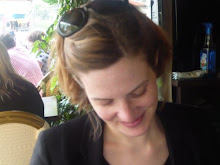ASOBU, HOMMAGE A HENRI MICHAUX
Josef Nadj
Cour d'Honneur du Palais des Papes
Tuesday July 11, 10pm
It is not very often, in contemporary dance performances, that one is treated to live music; on the stage of the Cour d'Honneur du Palais des Papes, choreographer Josef Nadj placed a jazz quartet, featuring no less than two double basses and an elaborate set of xylophones and bells, to perform a score by Akosh Szelevenyi and Szilárd Mezeï, running an emotional and stylistic gamut from high-on-acid free jazz to exquisite and dreamlike chimes.
The music and the dancing very much spring from each other, as is always the case with the works of great choreographers. That is not to say that I found Nadj's latest opus to be a masterpiece, but it certainly displayed substance, density and occasional moments of genuine grace.
Fans of Henri Michaux, I suspect, may be disappointed. A traveler and a poet, Michaux chronicled his impressions as he discovered Latin America and Asia with great conciseness, while in volumes such as Plume, he was jocular in depictions of absurd little scenes featuring a hapless and clueless character who is, for instance, removed from a restaurant and taken into custody by the police for ordering a dish that is not on the menu.
There is none of that in Nadj's ASOBU. Rather than the poet's humor and incisiveness, Nadj apes his boldness in reaching out for another's culture; from his traveling in Japan, he has brought back the stripped stage of Noh theater, a costume designer and several dancers, including four male butoh performers. The latter go through ritual-like motions that leave us as puzzled as Michaux and Nadj, no doubt, before the aliens' codes. Are we witnessing the staging of cliches, or is it a parody of cliches, when they don high hats and sit cross-legged with facial expressions that would definitely befit the actors of a Japanese soap opera - rolling eyes, lips puckered into an O.
Personally, those sections of the show left me uncomfortable. And as far as literature is concerned, I think that I am not alone in glimpsing at Kafka lurking in the wings rather than, or in addition to Michaux. The drab suits and dresses worn by the dancers could be a nod to Japan's aesthetics, from zen to Yohji Yamamoto, but could also be seen as the former Eastern European garments. Moreover, the anguish and insect-like quality of the movements was very reminiscent of Kafka's universe.
As in Kafka's works, moments of grace and humor emerged from long (repetitive?) sequences that forced the dancers into jumpy, almost epileptic movements keeping their limbs bent at all times. The moments of pure, intense poetry come from instance at the very beginning, when one of the Japanese female dancers just walks around the stage, alone, in slow motion and to the sound of exquisite, delicate chimes. There is none of the butoh's dislocation in her steps; she seems to be walking in the morning dew, as if she wanted to take delight in the dew under her bare feet and at the same time didn't want to crush the minute drops.
Also, thanks to the use of a large white screen, a shadow theater appears, behind which the dancers walked, their bodies oddly contorted, and thus projecting images that are uncannily insect-like. That sequence stands out because then, the use of the body and the dancers' skills, the impressionistic transformation of human beings into crawling cockroaches, was taken to a higher level, where one could revel in the black-and-gold enchantment that shadow theaters cannot fail to arouse.
Other moments of emotion were provided in the video projection onto the medieval walls of the Palais des Papes. The image of a horse, lying on its back and seemingly unable to get back up, would be just plain cruel if presented bluntly. But the music and the ancient, silvery quality of the photography gave it a space of its own, where it could be intriguing and take new meanings, new harmonics.
Finally, the "portés", as they're called in ballet, synthesized the themes and patterns of this work. Indeed, many of them, performed with bended knees and tense arms, very much feature the insect-like quality that I have repeatedly mentioned; Nadj may cringe at the idea that anything in his work is reminiscent of ballet,
but I could not help but think of Balanchine's repulsive, bald, all but naked men in "Prodigal Son", walking around in plié... In those portés, the dancer being carried seemed to be a burden or a prey. Yet some pas de deux were genuinely moving and inspiring, as when a dancer with Princess Leia like buns and the face of an ingenue, cuddled up atop her partner's shoulder, released strips of silver paper that were carried away by the Provence breeze.
Friday, July 14, 2006
Subscribe to:
Post Comments (Atom)


























 Emily Dickinson
Emily Dickinson




 Take the Quiz here!
Take the Quiz here!
No comments:
Post a Comment